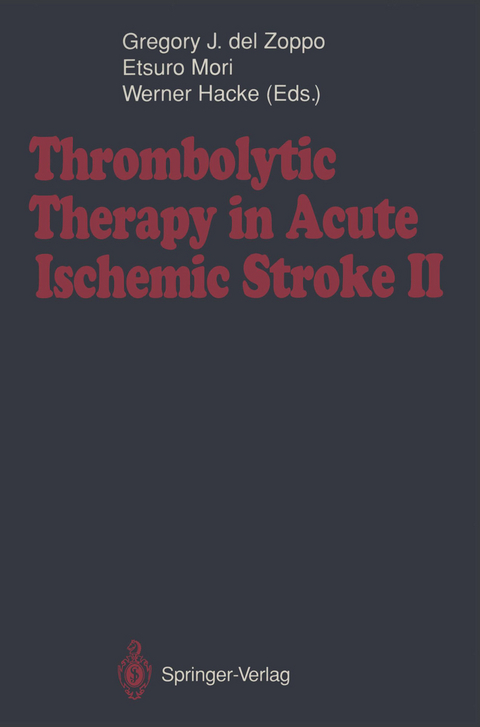
Thrombolytic Therapy in Acute Ischemic Stroke II
Springer Berlin (Verlag)
978-3-540-56442-3 (ISBN)
Background to Thrombolytic Therapy in Acute Ischemic Stroke.- Therapy for Acute Ischemic Stroke: Clinical Needs and Statistical Burdens.- Clinical Outcome of Acute Ischemic Stroke: Prospective Angiographic Studies.- The Ischemic Penumbra: Usefulness of PET.- Thrombolytic Agents: Lessons for Their Use in Acute Stroke from Myocardial Infarction Experience.- Pathogenesis of Secondary Brain Hemorrhage After Ischemia: Lessons from Animal Models ... and a few from man, too!.- Clinical Trials of Fibrinolytic Agents in Carotid Territory Cerebral Ischemia.- Symptom-Based Trials of Intravenous rt-PA in Acute Stroke.- A Safety and Efficacy Study of Intravenous rt-PA in Patients with Acute Stroke.- Recanalization, Infarct Volume, Cerebral Hemorrhage, and Clinical Outcome After Intravenous Recombinant Tissue Plasminogen Activator and Heparin in Acute Carotid Territory Stroke.- Intravenous Tissue Plasminogen Activator in Acute Thromboembolic Stroke: A Placebo-Controlled, Double-Blind Trial.- The European Cooperative Acute Stroke Study (ECASS).- On the Estimation of the Sample Size for the ECASS Study.- Australian Streptokinase Trial (ASK).- Thrombolytic and Antithrombotic Therapy in Acute Ischemic Stroke. Multicenter Acute Stroke Trial - Italy (MAST-I).- Discussion Summary: Clinical Trials in Progress.- Other Applications of Fibrinolytic Agents in the Central Nervous System.- Acute Central Retinal Artery Occlusion and the Role of Thrombolysis.- Current Status of Fibrinolysis for the Rapid Dissolution of Subarachnoid and Intraventricular Clot.- Discussion Summary: Other Applications of Fibrinolytic Agents in the Central Nervous System.- Insights into the Pathogenesis of Cerebral Ischemia Relevant to Fibrinolysis.- Deterioration of Acute Stroke.- Early Spontaneous Recanalization ofThromboembolic Stroke.- Spectacular Shrinking Deficits in Acute Ischemic Stroke.- The Significance of Various Factors Associated with Hemorrhagic Transformation in Patients Treated with Recombinant Tissue Plasminogen Activator for Acute Stroke.- Thrombolysis: Stroke Subtype and Embolus Type.- The Prognostic Value of Collateral Blood Flow in Acute Middle Cerebral Artery Occlusion.- Morphological Evidence of Progressive Microvascular Impairment in Middle Cerebral Artery Occlusion-Reperfusion.- Discussion Summary: Insights into the Pathogenesis of Cerebral Ischemia Relevant to Fibrinolysis.- Diagnosis and Assessment of Outcomes in Acute Cerebral Ischemia.- The Relevance of CT Scanning and Angiography for Patients with Acute Stroke Treated with Recombinant Tissue Plasminogen Activator.- Recanalization of the Embolically Occluded Middle Cerebral Artery in Acute Stroke Patients: Noninvasive Assessment and Outcome.- Potential Role of Magnetic Resonance Imaging in Selecting Patients for Thrombolytic Therapy.- The Role of SPECT in Acute Stroke Thrombolysis.- Clinical and Brain Hemodynamic Evaluations of Thrombolytic Therapy in Acute Ischemic Stroke: SPECT Study.- The Relevance of Neurological and Functional Outcome Scales for Acute Stroke Trials.- Discussion Summary: Diagnosis and Assessment of Outcomes in Acute Cerebral Ischemia.- Ancillary Therapy for Cerebrovascular Reperfusion.- Neuronal Protection and Recanalization Strategies: Is More Better?.- Strategies Which Decrease Post-Reperfusion Lipid Peroxidation.- Anti-PMN Leukocyte Strategies and Their Application to Focal Cerebral Ischemia.- Von Willebrand Factor as a Target for Antithrombotic Intervention.- Neuronal Protection: Is There a Role for Gangliosides or Ca2+-Channel Blockers?.- Discussion Summary: Ancillary Therapyfor Cerebrovascular Reperfusion.- Open Communications.- A Meta-Analysis of All Published Data on the Use of Thrombolytic Therapy to Treat Acute Ischemic Stroke.- Causes of Delayed Treatment of Stroke Patients Enrolled in t-PA Protocols.- A Demming Approach to Recruiting: The National Institute of Neurological Disease and Stroke (NINDS) t-PA Stroke Trial Experience.- Local Intra-arterial Fibrinolytic Therapy Within the Cerebral Arteries: Effectiveness of rt-PA Concerning Recanalization Rate and Time.- Relation of Thrombolytic Reperfusion and of Collateral Circulation to Outcome in Patients Suffering Cerebral Main Artery Occlusion.- Factors Related to Intracranial Hematoma Formation in Patients Receiving t-PA for Acute Ischemic Stroke.- Transcranial Doppler Sonographic (TCD) Monitoring of Basilar Artery Thrombolysis.- HMPAO SPECT Measures Reperfusion After Thrombolytic Therapy in Acute Stroke.- A Cell Culture Model of Reperfusion Injury: Neutrophil-Mediated Brain Endothelial Cytotoxicity.- Modification of Brain Ischemia Due to Embolic Stroke by Tissue-Type Plasminogen Activator With and Without Heparin in a Rabbit Model.- Reduction of Infarct Volume and Mortality by Thrombolysis with rt-PA in an Embolic Stroke Model.- Discussion Summary: Open Communications.- Clinical Trial Development.- Clinical Trials Sponsored by Companies Versus the NIH.- Blindness and Thrombolysis.
| Erscheint lt. Verlag | 3.6.1993 |
|---|---|
| Zusatzinfo | XIV, 334 p. 36 illus. |
| Verlagsort | Berlin |
| Sprache | englisch |
| Maße | 155 x 235 mm |
| Gewicht | 564 g |
| Themenwelt | Medizin / Pharmazie ► Medizinische Fachgebiete ► Intensivmedizin |
| Medizin / Pharmazie ► Medizinische Fachgebiete ► Neurologie | |
| Medizinische Fachgebiete ► Radiologie / Bildgebende Verfahren ► Radiologie | |
| Schlagworte | Computed tomography (CT) • Diagnosis • Intensivmedizin • nervous system • Neurologie • Schlaganfall • Thrombolyse |
| ISBN-10 | 3-540-56442-X / 354056442X |
| ISBN-13 | 978-3-540-56442-3 / 9783540564423 |
| Zustand | Neuware |
| Haben Sie eine Frage zum Produkt? |
aus dem Bereich


